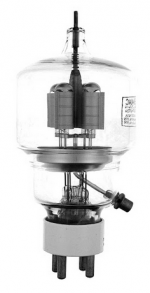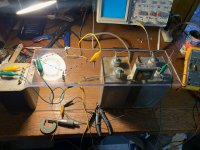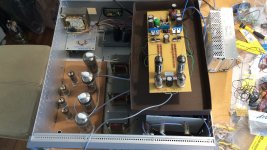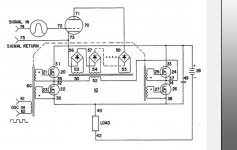The purging system is not difficult to follow. It just monitors if there is HV and if current flows thru the tubes. If both is available it then no purge is required. If there is no current flow but HV is available then it will be activated after some time (warming up time of the tubes). That's all.
If you want to start it without waiting you can manually purge (maybe because it is still warm after some servicing so no warming up time is required).
If you want to start it without waiting you can manually purge (maybe because it is still warm after some servicing so no warming up time is required).
it seems possible to create a full range version of the original speaker, using a carrier gas with a higher density such as Argon. This would be ideal because it would eliminate the need for crossovers and other problems related to conventional methods of sound production
A full range Hill would be awesome. I spent a good bit of time reading the patent and manual and all, and it appears Hill didn't consider full range practical. I believe he said it would take 4 times the power to extend the response an octave, and his units pull about a 1000 watts each. By this reckoning, (please correct me if I'm wrong) we are looking at over 100,000 watts for a single speaker that will go down to 40Hz.
Lampie519 has an approach that could very well improve efficiency using high frequency AC.
My ESLs went down to 600, had no trouble filling in the rest with conventional speakers.
I'm building the power supplies now, need to snag a good tube. I wonder how a eimac 304TL would do? Overkill? well, I already have a couple of them. 🙂
Attachments
Wow, nice tubes ! Just the heater supply will keep you warm in the winter, and that is just the supply ! Then the tubes plus the cathode current... no plasma spark yet... ha ha... that will add some more heat !
The nice thing about this speaker that we only need a preamp so that is a plus...
The amount of tubes can also be reduced if this kind is used. Only ballancing the plasma stream will be a challenge.
Therefore i was thinking of creating not parallel plasmas streams but cells.
Smaller ventillators can be used or distributed warm air streams.
Instead of ballast resistors light bulbs can be used (i do that sometimes if i do not know how much power i will dissipate)... The other advantage of light bulbs is that the resistance changes and ballancing is easier as it equals out better (must be tested)...
The nice thing about this speaker that we only need a preamp so that is a plus...
The amount of tubes can also be reduced if this kind is used. Only ballancing the plasma stream will be a challenge.
Therefore i was thinking of creating not parallel plasmas streams but cells.
Smaller ventillators can be used or distributed warm air streams.
Instead of ballast resistors light bulbs can be used (i do that sometimes if i do not know how much power i will dissipate)... The other advantage of light bulbs is that the resistance changes and ballancing is easier as it equals out better (must be tested)...
Last edited:
A full range Hill would be awesome. I spent a good bit of time reading the patent and manual and all, and it appears Hill didn't consider full range practical. I believe he said it would take 4 times the power to extend the response an octave, and his units pull about a 1000 watts each. By this reckoning, (please correct me if I'm wrong) we are looking at over 100,000 watts for a single speaker that will go down to 40Hz.
That calculation is correct in the case of Helium. However, in the case of other gases that are less thermally conductive such as Argon or regular air, conditions become adiabatic at much lower frequencies, allowing for more low-frequency extension without requiring more Watts. According to my VERY rough and untrustworthy calculations, a plasmaspeaker using the same amount of power as the Hill Plasmatronics, but using Argon instead of Helium should have a frequency response close to full range. However, the tradeoff to using Argon vs Helium is the much higher voltages required to strike a discharge between the electrodes.
...a plasmaspeaker using the same amount of power as the Hill Plasmatronics, but using Argon instead of Helium should have a frequency response close to full range. However, the tradeoff to using Argon vs Helium is the much higher voltages required to strike a discharge between the electrodes.
Once I get a test rig, I might try krypton. I have a small tank of it. What else will I use it for.?
Had weird tube dreams last night. Studying 4X150 and 6MJ6. The numbers don't add up on 6MJ6. Gm 7500 u mho, Rp 7000, Mu 3. If Gm = Mu/Rp it don't flush. Not even close. If it was off by 1000 or something I would blame the decimal point, but it's off in left field. At least one of those numbers is wrong. I'll try getting the numbers off the curves next.
For sure, a 4X150 will do a good bit more of everything than a 6MJ6, overkill really. The special socket and forced air is a pain, the advantage is I already have a few 4X150s.
Got a 3000 volt supply in the works:
Attachments
Good question. I do remember some numbers noted as triode connected, and something about Grid to screen. One thing is sure, a 4X150 will more than handle one glow discharge circuit. 🙂
The Plasmatronics plasma produces no Ozone at all as it is too hot and destroys it. It does produce oxides of Nitrogen.
"I plan to make a single unit. One tube, leaving the monitoring circuit out for the moment."
Only one cathode will result in a very unstable discharge. The combined currents of the five cathodes makes it much more stable. Even so, it must be sheltered from drafts.
"I plan to make a single unit. One tube, leaving the monitoring circuit out for the moment."
Only one cathode will result in a very unstable discharge. The combined currents of the five cathodes makes it much more stable. Even so, it must be sheltered from drafts.
6MJ6 in triode mode?
The 6MJ6 is used as a pentode: screen grid at ~150V, suppressor tied to cathode. Plate voltage is ~1100V at ~30mA while running. The tube is pushed right to its limits.
Last edited:
Hill experimented with different gasses. he mentioned hydrogen and argon. Hydrogen produces water vapor if any air gets in, not good. Argon costs more than helium, and though I like the inert gasses, the others are even more expensive. I have a small tank of krypton, but at 50 cents a liter, forget that. Neon would be pretty too. So, what about nitrogen? If we can keep out the oxygen, no poisonous gas issues. And what about CO2? Would it break down in the glow? Thought about freons, but those might break down, then you get fluorine, chlorine, carbon, hydrogen, blah!
I'm sure Hill had a good reason for helium, but it's worth a try to find a cheaper option. Still have not given up recycling the gas.
Argon is way cheaper than Helium, but the latter has properties that make it better for the speaker. The Hydrogen speaker prototype Alan made went lower in frequency, but the water vapor is highly electro-negative and also causes a lot of noise at the cathode. He gave it up shortly after learning that.
He has a new idea for a wider range driver and is talking to investors.
The 6MJ6 is used as a pentode: screen grid at ~150V, suppressor tied to cathode. Plate voltage is ~1100V at ~30mA while running. The tube is pushed right to its limits.
We (Thobias and i) were thinking of using the PL519 tube as it is very robust and available. It could handle this amount of "abuse".
The other option would be using some RF oscillator (about 300kHz or so) instead of a DC voltage. This could increase the effiency.
Attachments
I recall Alan saying something to the effect that AC was not good because of the current going through zero all the time. The plasma responds very quickly - probably faster than 300kHz.
The rectifier in the lower left of the original schematic should be turned 90 degrees...
Good catch! I was only 21 years old at the time and should have caught that error. It was done in ink and was not simple to erase without making a hole in the velum. I don't remember after all these years if I just hoped it was not going to be noticed.🙄
It is only important if you are going to build one or have to repair it... and if you are savvy enough to build one you will notice this error and have done with it..
AC doesn't need to go through zero but can be above a DC voltage (always positive). So this could work.
I misunderstood your earlier comment - thinking you were suggesting an AC discharge.
My understanding (from Alan) is if the plasma current goes to zero, even briefly, it becomes unstable. The recombination rates are fast - I don't have exact numbers, but a few microseconds seems plausible. Best to be aware of this possibility. Also be aware that a single channel test, at say 35mA, will not be stable at all because the total current in the discharge will be less than what is needed to keep it alive. I know this from direct experience. I have to run all five channels to get it to stay lit.
And feeding it AC could adds noise to it as well, so it needs to be of a very high frequency i guess...
Now i use ionic tweeters running on 27MHz, these are dead quiet and very clean (no ozon as well). I was thinking of building a line source using multiple tweeters.
Tobias still dreams of building a Helium plasma speaker so i will support him with this project as much as i can.
So any help is welcome !
"In order to keep the discharge alive you will need all 5 channels", i understand...how about 4 passives and 1 active channel (for testing purposes)?
Now i use ionic tweeters running on 27MHz, these are dead quiet and very clean (no ozon as well). I was thinking of building a line source using multiple tweeters.
Tobias still dreams of building a Helium plasma speaker so i will support him with this project as much as i can.
So any help is welcome !
"In order to keep the discharge alive you will need all 5 channels", i understand...how about 4 passives and 1 active channel (for testing purposes)?
it seems possible to create a full range version of the original speaker, using a carrier gas with a higher density such as Argon. This would be ideal because it would eliminate the need for crossovers and other problems related to conventional methods of sound production.
Alan Hill always said the power required to drive the plasma doubles for every octave lower. This makes it impractical to make a full range speaker, but one octave lower would be pretty great.
BTW: The power dissipated in Alan's plasma alone is less than 300W. The rest is dissipated in the ballast resistors, the tubes, and the tube filaments.
- Home
- Loudspeakers
- Planars & Exotics
- Hill Plasmatronics: Bit by the plasma bug





